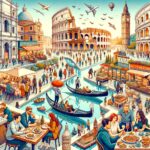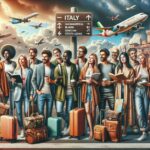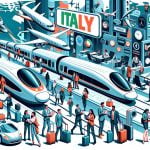How did people travel in 1565 Italy? The modes of transportation in 16th century Italy were varied and influenced by numerous factors such as social status, geographical location, and purpose of travel.
From horse-drawn carriages to travel by water, the means of getting around were integral to the daily lives of Italians during this time. In this article, we will explore the fascinating world of travel in 1565 Italy, shedding light on the different facets of transportation and their significance in shaping Italian society.
In 1565 Italy, transportation played a crucial role in everyday life, connecting cities and facilitating trade, communication, and cultural exchange. With a diverse range of modes including horses and carriages, boats and gondolas, as well as walking along roads and paths, travel was deeply ingrained in the fabric of society. Understanding how people navigated through this rich historical landscape allows us to appreciate the complexities and nuances of Italian life during this period.
From the bustling streets of Venice to the picturesque countryside of Tuscany, each region had its own unique transportation infrastructure that catered to the needs of its inhabitants. Traveling was not only a necessity for many but also a source of pleasure and adventure for those who sought to explore new territories.
By delving into the various aspects of travel in 1565 Italy, we can gain insight into the intricacies of daily life and the broader historical context that shaped Italian society at that time.
Modes of Transportation in 1565 Italy
Traveling in 1565 Italy involved a variety of modes of transportation that were essential for both personal and commercial travel. The available methods of transportation during this time period were crucial in shaping the socio-economic landscape of Italy. Here are some of the key modes of transportation that were commonly used in 1565 Italy:
- Horses and Carriages: Horse-drawn carriages were a common mode of transportation for those who could afford it. They provided a more comfortable and efficient way to travel longer distances, especially for the upper class and nobility.
- Travel by Water: Italy’s extensive network of waterways made boats and gondolas an important means of transportation. Venice, for example, was known for its intricate canal system which facilitated trade and transportation via gondolas.
- Importance of Roads and Paths: Inland travel in Italy heavily relied on well-maintained roads and paths. These routes allowed for the movement of goods, people, and communications between different regions within the country.
The utilization of these various modes of transportation greatly influenced the interconnectedness and development of different regions within Italy during this period.
Understanding how people traveled in 1565 Italy provides valuable insight into the historical context and advancements in transportation that shaped the everyday lives of individuals living during this time period.
The Role of Horses and Carriages in 1565 Italy
In 1565 Italy, the role of horses and carriages was integral to the transportation system of the time. This section will explore the significance of these modes of transportation in facilitating travel for various purposes such as trade, commerce, and personal travel.
Utilization of Horses
Horses were a valuable means of transportation for both short and long distances in 1565 Italy. They were utilized not only for travel but also for transporting goods and materials. Wealthy individuals and nobility often owned and used horses for their personal transportation needs, while merchants relied on them to transport goods across different regions.
The Importance of Carriages
Carriages played an important role in providing comfortable and efficient means of travel in 1565 Italy, especially for those who could afford them. Carriages varied in design and size, ranging from simple carts to ornate coaches. They were essential for transporting individuals across longer distances or for leisurely rides within cities and towns.
Impact on Society
The availability of horses and carriages had a significant impact on society in 1565 Italy. It allowed for increased mobility, facilitating trade and communication between different regions. Furthermore, it provided opportunities for social interaction as people traveled to attend events, visit family members, or conduct business. The use of horses and carriages also contributed to the development of road networks, as routes were established to accommodate these modes of transportation.
Understanding the role of horses and carriages provides insight into how people traveled in 1565 Italy, shaping the experiences of individuals and communities during this fascinating period in history.
Travel by Water
In 1565 Italy, traveling by water was a common and important mode of transportation. With the abundance of rivers, canals, and coastal areas, boats and gondolas played a crucial role in the movement of people and goods throughout the country. The use of waterways provided a convenient and efficient means of travel, especially in regions where road infrastructure was lacking or inadequate.
Boats were used for various purposes in 1565 Italy, ranging from fishing and trade to transportation for individuals. Larger vessels were employed for trade between different cities and regions, carrying commodities such as grain, wine, and textiles. On the other hand, smaller boats were utilized for personal travel along rivers and canals, offering a scenic and leisurely way to explore the picturesque Italian landscape.
The iconic gondolas of Venice also played a significant role in transportation during this time period. These sleek, black boats were propelled by skilled gondoliers using oars, navigating the intricate network of canals that served as the lifeblood of the city. Gondolas were not only a practical means of getting around but also became synonymous with romance and elegance, adding to the allure of traveling by water in 1565 Italy.
| Transportation Mode | Role |
|---|---|
| Boats | Used for trade and personal travel along rivers and canals |
| Gondolas | Iconic mode of transportation in Venice; used for both practical travel and romantic experience |
The Importance of Roads and Paths for Travel in 1565 Italy
Traveling during the Renaissance period in Italy was a challenging but fascinating experience. In 1565, the importance of roads and paths for travel cannot be overstated. The road network in Italy at this time was crucial for facilitating trade, communication, and mobility across the peninsula.
In 1565 Italy, the road network was primarily used by merchants, travelers, and military forces. Roads were not as advanced as they are today, so traveling by foot or horseback was the most common mode of transportation. The condition of the roads varied greatly depending on the region, with some areas having well-paved routes while others had rough and uneven terrain.
For those who could afford it, traveling by carriage was a more comfortable option. Carriages were typically used by the wealthy or nobility to move between cities or towns. The use of carriages allowed for greater speed and comfort compared to traveling on foot or horseback.
The road network also played a significant role in connecting different regions of Italy and facilitating trade between cities. This allowed for goods such as spices, silk, and other valuable commodities to be transported more efficiently, contributing to the economic prosperity of many Italian city-states during this time period.
Overall, understanding the importance of roads and paths provides valuable insight into how people traveled in 1565 Italy and helps us appreciate the challenges they faced while moving through the Italian landscape.
- Road conditions
- Importance of roads for trade and communication
- Use of carriages by wealthier travelers
Traveling on Foot
In 1565 Italy, the most common mode of transportation for the majority of people was traveling on foot. With a lack of widespread access to horses and carriages, walking was not only the most practical option, but also the most affordable for the average person. Whether it was for daily tasks, commuting to work, or making long journeys, walking played a crucial role in the lives of Italians during this time period.
According to historical records, the roads and paths in 1565 Italy were often narrow and unpaved, making travel by foot both challenging and arduous. However, despite the difficult terrain, many Italians were accustomed to traversing these pathways on a regular basis. This reliance on walking as a primary mode of transportation also influenced the layout and design of cities and towns, with infrastructure being developed to accommodate pedestrian traffic.
For those who could afford other modes of transportation such as horses or carriages, they were often reserved for the wealthy elite or nobility. The majority of Italians had little choice but to rely on their own two feet to get from place to place. The lack of modern transportation technology meant that walking remained an integral part of daily life for people from all walks of life in 1565 Italy.
| Italy Mode of Transportation | Frequency |
|---|---|
| Walking | Most common |
| Horses and Carriages | Reserved for wealthy elite |
The Influence of Trade Routes on Travel in 1565 Italy
Trade routes played a crucial role in shaping the modes of transportation and travel in 1565 Italy. The flourishing trade between Italian city-states and other regions necessitated the development of efficient transportation systems to move goods across different areas. As a result, these trade routes also facilitated the movement of people, leading to the evolution of various means of travel.
Impact on Land Transportation
The existence of trade routes significantly impacted land transportation in 1565 Italy. The need to transport goods quickly and efficiently led to the improvement and expansion of roads and paths connecting different cities and towns. These well-maintained routes not only facilitated the movement of merchandise but also allowed for easier travel by horse or carriage. As a result, trade routes indirectly influenced the accessibility and convenience of travel for both goods and people.
Development of Water Routes
In addition to land-based trade routes, waterways were also crucial for transporting goods across Italy during this time. Rivers such as the Po played a significant role in connecting inland regions with coastal areas, allowing for the easy movement of cargo by boat. This reliance on water routes also impacted travel for individuals, as boats and gondolas became common modes of transportation for both passengers and goods traveling between different cities along these waterways.
Cultural Exchange and Travel
The influence of trade routes on travel in 1565 Italy extended beyond just providing practical transportation options. These well-traveled paths facilitated cultural exchange as people from different regions interacted during their journeys. The movement of traders, merchants, and travelers along these routes contributed to the exchange of ideas, languages, customs, and traditions-a factor that enriched Italian society during this period.
Overall, it is clear that trade routes had a profound impact on travel in 1565 Italy. By shaping land-based transportation systems, influencing water routes, and facilitating cultural exchange, these trade networks contributed to the diverse landscape of travel experiences within Italy during this historic period.
Traveling for Pleasure
In 1565 Italy, traveling for pleasure was a luxury reserved for the wealthy and noble. Those who had the means to do so often embarked on journeys to explore different regions of the country or to visit renowned cultural and artistic centers. The experience of travel for pleasure during this time was vastly different from modern-day tourism, as it was characterized by a slower pace and a focus on cultural enrichment.
For the elite class, traveling for pleasure often meant embarking on grand tours, which were extended trips across Europe that included visits to major cities such as Rome, Florence, Venice, and Milan. These journeys were seen as an essential part of a young aristocrat’s education, providing exposure to different cultures, languages, and artistic traditions.
Travelers would immerse themselves in the artistic and architectural wonders of these cities, commissioning famous artists to create portraits or purchasing valuable works of art as souvenirs.
The act of traveling for pleasure in 1565 Italy also involved indulging in luxurious accommodations and fine dining experiences along the way. Wealthy travelers would stay in opulent palaces or grand villas, enjoying the finest cuisine prepared by renowned chefs.
This aspect of travel emphasized the leisurely nature of the journey and allowed individuals to fully immerse themselves in the lavish lifestyle associated with aristocratic travel. Overall, traveling for pleasure during this time was a symbol of social status and sophistication, offering a glimpse into the opulent world of the Italian elite in the 16th century.
Conclusion
Traveling in 1565 Italy was a vastly different experience compared to the modern conveniences we enjoy today. The modes of transportation available during this time period were limited, yet they played a crucial role in shaping the culture and economy of Italy.
From horse-drawn carriages to travel by water, the means of getting from one place to another were diverse and had their own unique impacts on society. Understanding how people traveled in 1565 Italy provides valuable insight into the historical context of the time and helps us appreciate the advancements made in transportation over the centuries.
The reliance on horses and carriages for both personal and commercial travel was a defining aspect of transportation in 1565 Italy. These modes of transport were essential for conveying people and goods across long distances, contributing to the development of trade routes and the interconnectedness of different regions.
Similarly, travel by water, whether through boats or gondolas, was integral to Italy’s transportation network, particularly in coastal areas or along major rivers. This mode of transportation not only facilitated trade but also provided a unique cultural experience for travelers as they navigated through picturesque waterways.
Additionally, the extensive network of roads and paths throughout Italy significantly influenced how people moved from place to place in 1565. These routes were essential for facilitating travel on foot, which was the most common mode of transportation for many individuals at the time.
From merchants transporting their wares to pilgrims embarking on religious journeys, traveling on foot was a ubiquitous aspect of daily life in 1565 Italy. Overall, gaining insight into how people traveled in 1565 Italy allows us to appreciate the rich tapestry of historical transportation methods that have contributed to shaping modern-day Italian culture and society.
Frequently Asked Questions
How Were Ideas Quickly Spread During the Time of the Renaissance?
During the Renaissance, ideas were quickly spread through a combination of factors. The invention of the printing press enabled the mass production of books, allowing knowledge to be disseminated widely. Additionally, the increased trade and travel across Europe facilitated the exchange of ideas between different regions.
How Was Italy During the Renaissance?
Italy during the Renaissance was a vibrant and dynamic place, known for its flourishing cultural and artistic developments. Cities like Florence, Rome, and Venice were centers of innovation in art, architecture, literature, and science. The wealthy merchant class in Italy patronized artists and scholars, contributing to the remarkable achievements of this period.
When Was the Age of Exploration in the Renaissance?
The Age of Exploration in the Renaissance took place primarily from the 15th to 17th centuries when European powers began to explore and establish overseas colonies. This era saw significant advancements in navigation technology, leading to explorers like Christopher Columbus sailing to the Americas and Vasco da Gama finding an ocean route to India.
These voyages had far-reaching impacts on global trade, colonization, and cultural exchange.

I’m a passionate traveler, writer, and Italophile. My fascination with Italy’s history, art, and culture has led me on countless adventures across the Italian landscape. Through “I Live Italy,” I share my love for this extraordinary country and aims to inspire others to explore its boundless beauty.





